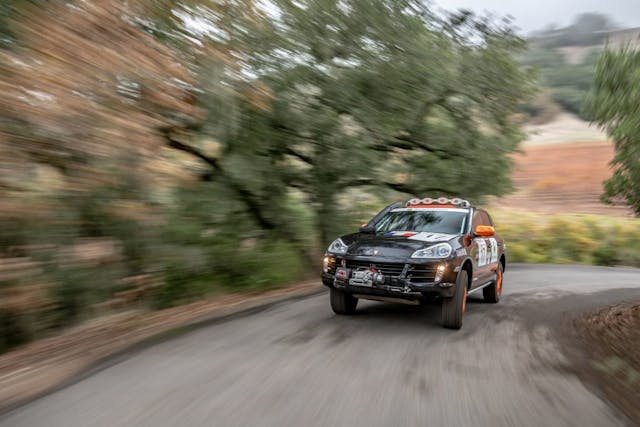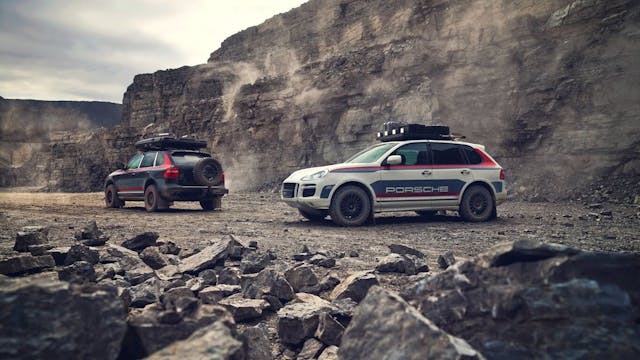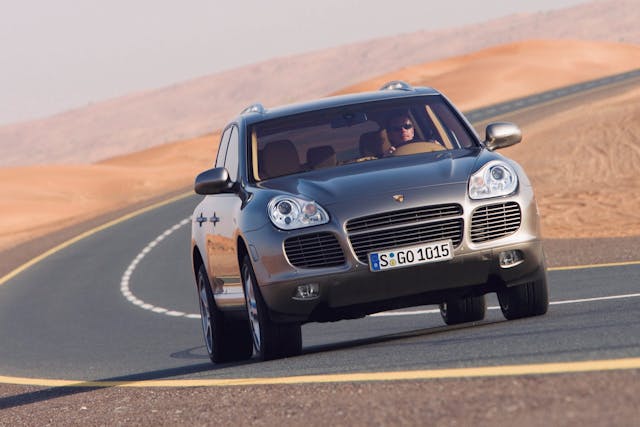Pigs still can’t fly, but the Porsche Cayenne is starting to become collectible
Bob Dylan performed his first electric concert at the Newport Folk Festival in 1965. For acoustic music aficionados in those days, guitars with pickups were the devil. Seeing Bob plug in was viewed as the ultimate betrayal, prompting enraged shouts of “Judas,” severely harshing the mellow of the event, or whatever. But the protestations of snobby folkies 55 years ago paled in comparison to reaction of the Porsche faithful in 2003 when the Cayenne SUV was introduced.
In addition to the garden-variety wailing and garment rending, there were also predictions of the imminent demise of the marque. The petulance factor was off-the-charts—“If this is the price of Porsche’s continued existence, then I say, let them die with dignity” was representative of the opinions of the most extreme. In other words, the enthusiasts hated it. So, predictably, the Cayenne was a massive sales hit, (notwithstanding the now quaint-seeming histrionics). Almost 20 years later, there’s peace in Porscheland—the Cayenne has been fully embraced by even the most fervent brand junkies. I know more than a few Porschephiles who wouldn’t dream of using anything other than a Cayenne to tow their track cars.
As a testament to how right Porsche got things with the first-generation Cayenne (known internally as the E1 or 955), the remaining good ones are being snapped up by those in the know. Clearly, at some point in the last year or so, early Cayennes went from the favored mounts of the look-rich-for-cheap/poseur crowd to enthusiasts with pockets deep enough to keep good ones on the road. The days of decent early Cayennes as fodder for “buy here, pay here” lots is about over. Data from the insurance side of Hagerty’s business confirms something is going on: More people are calling us for quotes on insurance for Cayennes and they’re stating higher values for them (in April the average was $18,000, which is 15 percent higher than the year before).

It’s hard to say why this is occurring. The passage of time and inevitable attrition that makes once-common vehicles seem exotic no doubt plays a factor. First-gen Cayennes have now been out of production long enough that factory support for them is the responsibility of Porsche Classic. (Porsche will even modify old Cayennes as part of its Exclusive Manufaktur program.) The relentless increases in size and refinement in modern luxury SUVs, Cayenne included, may be making the originals seem honest in comparison. Factor in its genuine off-road prowess, and its family resemblance to the now-hip 996, and it starts to become more clear why so many people that I know are searching for nice first-gen (2003–2006) Cayennes. And it’s not just people looking for roomy, powerful winter transport. E1s are becoming the blank canvas for some really spectacular builds. Support through the Porsche Club of America is excellent too, with helpful how-to videos and ready access to sound advice.
There is a definite pecking order in early Cayennes. Few people seem to seek out the underpowered 247-hp base cars with lightly modified 3.2 liter VW VR6 narrow-angle V-6s—the exception to this rule being the few manual transmission V-6s. The sweet spot for budget shoppers is the Cayenne S, powered by a fairly bullet-proof 340-hp, 4.5 liter V-8 (decent ones are in the $10,000 to $11,000 range). The 2006-only Titanium Edition is cool and underappreciated, with an alloy hood, titanium trim, and some different colors and interiors. Strangely, the 450-hp Turbo doesn’t fetch much more than the naturally aspirated S. The added complication and exponentially higher maintenance costs scare off a lot of people at this price point. The monstrous 520-hp Turbo S, however, is simply too tempting for many, who will throw caution to the wind. A nice Turbo S will likely cost you more than $20,000.
Cayennes are generally rugged, and their weak spots have been well-documented, and in most cases, fixed. For example, the V-8 E1 Cayenne initially came with plastic coolant pipes located in the hottest part of the engine compartment, under some plastic cladding in the central valley of the engine. Predictably, after numerous heat cycles, the pipes failed, sometimes catastrophically. Most early V-8 Cayennes have long since gotten upgraded aluminum pipes. Cardan shaft bearing supports fail every 100,000 miles, but the aftermarket has several cost-effective solutions for that, as well as the steering-column failures that afflict some models. Occasionally, a transfer case will fail. Cars equipped with air suspension will also wind up costing a fair bit to fix eventually, or not—you can always convert them to steel springs.

Many things on the Cayennes are, believe it or not, DIY-friendly. Some, however are maddening. Changing an alternator falls into this category; it takes about five hours. Even swapping out a battery is an exercise in frustration—it’s located under the driver’s seat, and yes, you have to unbolt the seat and tilt it back until there’s just enough clearance to heave out a 50-pound battery. Not much fun.
Early Cayennes also wear pretty well cosmetically. Body finish and galvanizing was excellent. I have yet to see a seriously rusty Cayenne. Tiptronic automatics are also pretty stout. 2005 model year Cayennes occasionally have transmission valve-body issues that result in hard downshifts, but there are several companies who will rebuild just the valve-body for around $600. The R and R is a DIY job. My Cayenne, at 157,000 miles, has yet to use an appreciable amount of oil between changes. Like a hypochondriac who panics because he can’t find his pulse, I find the lack of oil consumption to be downright eerie.
To the naysayers who opined that collectability is a mere pipe dream for the Cayenne, I would say “not so fast.” Turbo S models seem to be increasing in value, as do post-facelift 2008 GTSs, particularly those with manual transmissions. And if the frightfully troublesome Land Rover Discovery can develop a cult following (which is most certainly has), why not the first Porsche SUV?
Rob Sass is the editor-in-chief of Porsche Panorama, the official publication of The Porsche Club of America.


